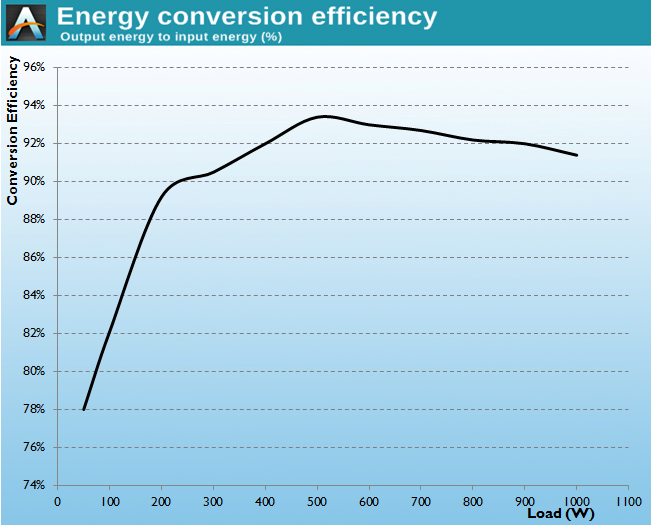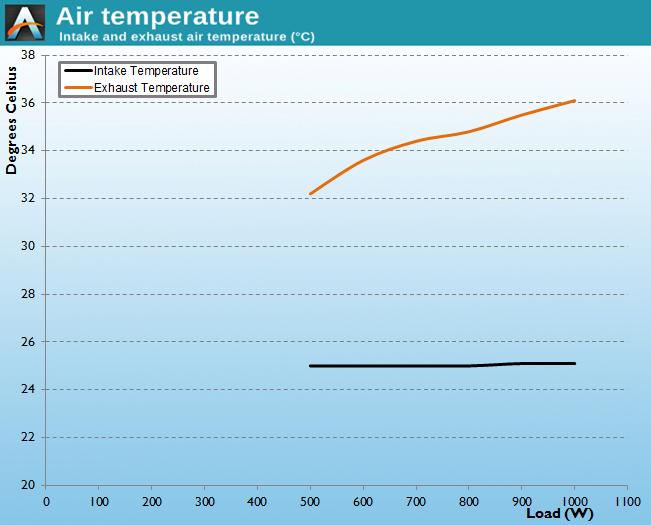Corsair RM1000 Power Supply Review
by E. Fylladitakis on April 24, 2014 6:00 AM EST- Posted in
- Cases/Cooling/PSUs
- Corsair
- PSUs
- RM Series
Cold Test Results
For the testing of PSUs, we are using high precision electronic loads with a maximum power draw of 2700W, a Rigol DS5042M 40MHz oscilloscope, an Extech 380803 power analyzer, two high precision UNI-T UT-325 digital thermometers, an Extech HD600 SPL meter, a self-designed hotbox, and various other bits and parts. For a thorough explanation of our testing methodology and more details on our equipment, please refer to our How We Test PSUs - 2014 article.
The Corsair RM1000 performs very well at room temperature, easily surpassing the 80Plus Gold Certification limits and reaching a maximum efficiency of 93.4% at 50% load. The average efficiency of the RM1000 within the nominal load range (20% to 100%) is 91.8%, which is an astonishing figure. When the load is reduced down to 50W, the efficiency drops down to 78%; however, although that may sound like a poor result, we should clarify that this actually is a very good figure and rarely can a PSU maintain an efficiency this high at just 5% load. However, such a low load is considered an "out of range" condition and does not affect the 80Plus certification, which takes into account only the 20% to 100% nominal capacity range.
There are no exhaust air temperature or noise measurements below 50% load because the fan does not spin until we reach 500W. The RM1000 is virtually inaudible while operating at room temperature, even when heavily stressed. Due to the passive cooling profile and the small heatsinks, however, the RM1000 tends to run warm, with the temperature of the tiny secondary side heatsinks floating around 55 °C and reaching up to 59.7 °C.















55 Comments
View All Comments
ssj3gohan - Monday, April 28, 2014 - link
Can I give some constructive criticism?The review is missing some parts that would be very useful:
- The teardown is extremely short and basically useless. All the information we get from it is that it's made by CWT. There is a lot more to see that is relevant, like the topology (it's obviously LLC resonant, otherwise the heatsinks for the active devices could never be that small even for a lower powered unit. They dissipate so little because they are switched at zero voltage and current all the time (ZVCS) instead of only half of the time (pseudoresonant) or never (traditional push-pull). Switching losses are the biggest issue in high current PSUs. Another important thing to note is the make of the controller chip(s), as this usually gives a good idea of the modern-ness of the design (LLC resonant has been around for 20 years, but only recently have they really started to do propagation time compensation and such awesomeness). It's also important to note that for instance on this unit, the non-important cap (input filter cap) is from a good brand and the caps that actually matter (high ripple current, high stress in general) are B or C grade. CapXon is not something I would trust handling a couple tens of amps of ripple current for 5 years. Lots of reviewers get fooled by the big shiny cap on the input having the good markings, but this misses the point of cap quality inspection. There's more that should be in the teardown, but for that I'd just recommend aping Jonnyguru, X-bit labs or such people.
- On the hot *and* cold tests (as well as crossload), at least include a table of the actually used loads and results in numbers, as well as your total (un)calibrated error - depending on whether all your instruments are calibrated or not.
- Don't fucking interpolate to get nice graphs! This is a deathly sin in data processing. It causes all kinds of crazy things, like implying that the slope of the efficiency graphs is a certain value at the edges (while it probably is something completely else) and causing the weird ripples in the efficiency curve you see. I'd bet money that that ripply stuff is just measurement error. In fact, the entire graphs are a big departure from both the 80 Plus test report and other review sites, so even if this is not actually an error on your part, we need to be able to properly compare this (with table values) to be sure. Even just the sentence 'this PSU was tested on 230VAC input while most other sites test at 115VAC input; this may inflate efficiency numbers' would greatly improve the review.
- This leads to the next point: interpret the data for us, give us a well-researched explanation for weirdness. Why do the SPL numbers look the way they look? Did you have a tachometer? Did the sound have a broad spectrum or was it whiny?
- Also: another case of interpolation causing weird graphs is the heatsink temperature graph. Cut that graph in the middle, and annotate it on the left with 'fan off' and on the right with 'fan on'. Don't try to connect the two separate domains, it is meaningless and just causes weird bumps in the graph that are not there!
- In the conclusion, don't just give a conclusion on this unit in a vacuum. You're a review site! You are supposed to know the market, know the competition. Tell us how the unit performs compared to the competition and how well it is priced. THEN give us a recommendation. Take into account the industry standing of the brand and previous PSUs. As it stands, the conclusion is not satisfactory.
I'm not trying to be harsh, but Anandtech has a good reputation and there are too few good PSU reviewers around on the internet. You're one of only 3 semi-fulltime PSU reviewers with a master's and/or PhD in the right area, so I have high hopes for the future. I already had high hopes when you were introduced for the first time, but the reviews so far have been passable instead of great. This needs to be fixed.
Michal Daniel - Wednesday, April 30, 2014 - link
Makes for a splendid hackintosh. Typing this on it.http://www.proofsheet.com/macbeast/all.html
amazingrugs - Friday, May 9, 2014 - link
I've been out of the building game for quite a while. I think the last system I built had a Radeon 9500, when AGP was all the rage! What kind of system does it take to push a PSU like this?alostpacket - Thursday, May 15, 2014 - link
You guys should never post after-rebate prices, you are doing their marketing for them.burningisis - Monday, November 16, 2015 - link
I think another use for a high wattage PSU like this other than mining or those using autocad... future proofing a machine. I know I've replaced enough PSUs on my machines as I upgrade GPUs or upgrade the number of drives I use or if I decide to push overclocking. I know some users are going smaller but there are users still out there demanding larger PSUs, running 3+ GPUs, running multiple processors on an enthusiast system. It may be a small subset of users, but there is a demand out there for these, and this looks like a very nice PSU to future proof a build as well